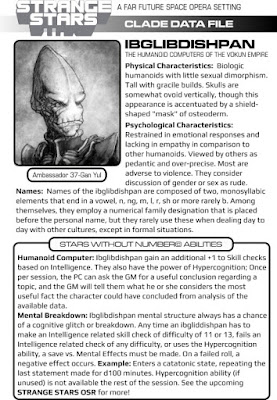A few weeks ago, Rob Barrett made a request in the comments of
this post for "more recent SF" suitable for
Strange Stars inspiration. In the section on galactic adventuring, I relied mostly on older, well-known and non-science fiction references because I want to convey the idea that the setting is easily accessible and usable for the sort of stuff people typically use science fiction games too do.
That doesn't mean science fiction from the past twenty years hasn't been an influence on the conception and development of
Strange Stars. I mentioned a few of these in the intro of the setting book, but here are a few more:
Hannu Rajaniemi.
The Quantum Thief;
The Fractal Prince;
The Causal Angel. This series is one of the biggest inspirations for Strange Stars, but its influence is diffuse. The interaction of information and physical life that pervades the series is very Strange Stars, as are the exotic societies of Earth, Mars, and the Oort Cloud.
Greg Egan.
Diaspora. The conception of moravec, infosophont, and biologic groups was inspired by Diaspora, specifically, w
Alastair Reynolds.
The Prefect;
Chasm City. The Glitter Band is a great example of the varied polities of the League of Habitats or the Circus. The Ultras have some resemblance to the Star Folk, if not the same style. Chasm City in particular would make a pretty good Strange Stars adventure.
Karl Schroeder.
Permanence. The primary inspiration for the metascape is the exoscape of
Permanence.
Charles Stross.
Glasshouse;
Accelerando; the books in the Saturn's Children universe:
Saturn's Children and
Neptune's Brood. The technology and economic considerations in Stross's novels underpin similar concepts in Strange Stars. If you want to really get a feel for how I envision fabbers, read
Glasshouse.
Neptune's Brood also has a very well-realized "water world."
Scott Westerfield.
The Risen Empire (Succession Book 1). Though I haven't written a lot about military matters in
Strange Stars material, the planetary assault and space battle in this book greatly informed what I think such things would look like among "modern" powers in the setting.
John C.Wright.
The Golden Oecumene trilogy and related stories. The technology of the Golden Oecumene with the trappings of Cordwainer Smith's Instrumentality of man gets you a good representation of the Radiant Polity. The novella "
The Far End of History: A Tale from the Last Days of the Seventh Mental Structure" is a great example of what sort of things went on in the Archaic Oikumene.
































